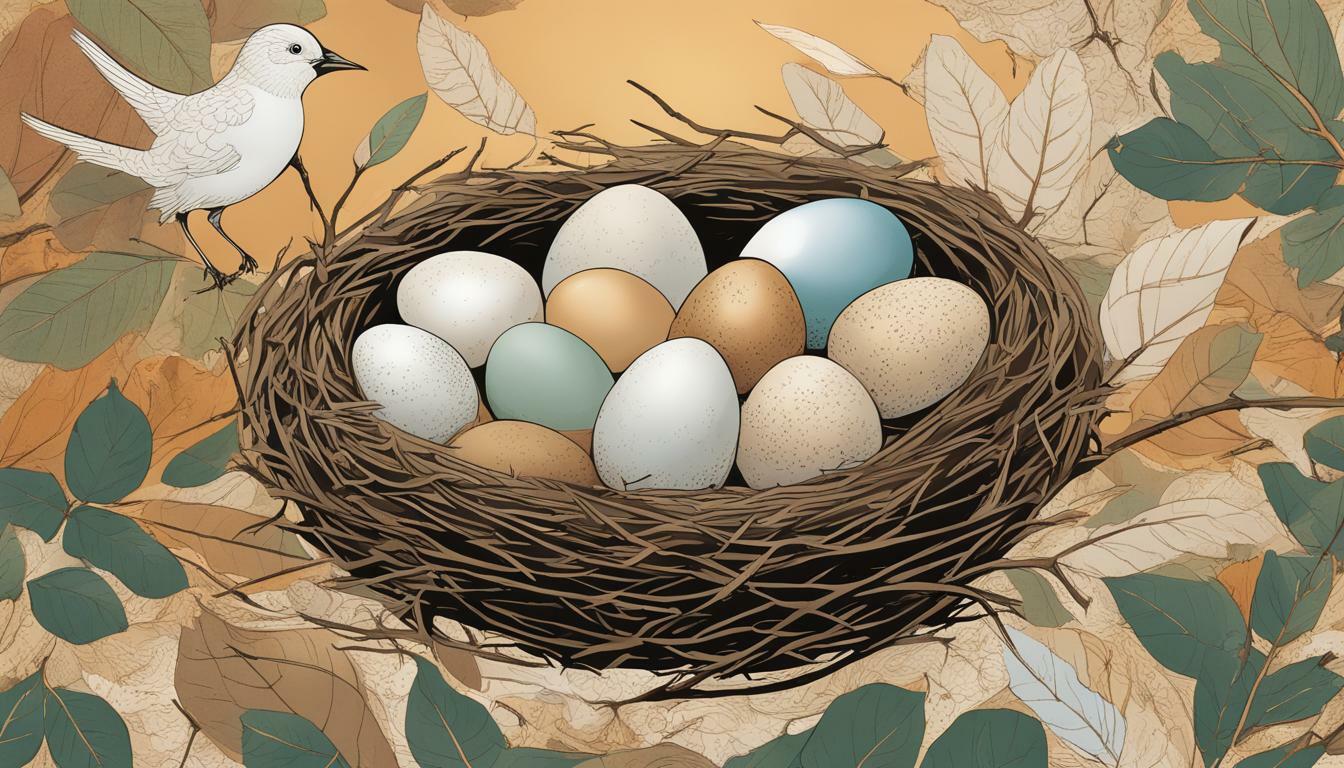If you’re curious about bird reproduction, you may have wondered, do all birds lay eggs? The answer is no, but the vast majority do. There are over 10,000 species of birds, each with their unique way of reproducing.
The act of laying eggs is essential to bird species and is a defining characteristic of avian reproduction. From tiny songbirds to giant ostriches, birds lay eggs that can vary greatly in size, shape, and color.
- Not all bird species lay eggs
- Birds have a unique reproductive system
- Egg-laying plays a crucial role in avian species
Avian Reproduction and Nesting Habits
Avian reproduction is a fascinating process that involves unique behaviors and adaptations. Unlike most mammals, birds lay eggs to reproduce, and their nesting habits are diverse and specialized.
Birds have a variety of strategies for reproduction, including internal fertilization and external fertilization. Some species even have multiple partners and mating systems. Once fertilized, the eggs develop within the female bird’s body, with each egg receiving its shell just before it’s laid.
When it comes to nesting habits, birds have evolved a range of behaviors and adaptations to suit their habitats and lifestyles. Some birds build intricate nests using materials like twigs, grass, mud, and even spider webs. Others use existing structures such as tree cavities, burrows, or cliff faces. Some birds even create nests using their own saliva or feathers.
Avian reproduction and nesting habits vary greatly among different species, reflecting the incredible diversity and adaptability of birds. Whether they live in forests, deserts, oceans, or cities, birds have evolved an impressive array of reproductive and nesting strategies that allow them to thrive in a wide range of environments.
Types of Bird Eggs
Bird eggs come in a wide variety of sizes, shapes, colors, and patterns. No two eggs are exactly alike, and each species has developed its unique adaptations to ensure survival in specific environments. Bird eggs are also a crucial source of nutrition for predators and scavengers, making their characteristics and properties vital to many other species in the ecosystem.
The shape of bird eggs can range from spherical to cylindrical to oval, depending on the species. Shape can play a crucial role in the incubation and hatching of the egg, as well as protecting the embryo from damage. For example, the pointed shape of a plover’s egg allows it to spin in a circle, which prevents it from falling out of the nest.
Size is another important characteristic of bird eggs, and it can vary significantly depending on the species. The smallest bird egg belongs to the hummingbird, measuring just 0.5 inches long and weighing only 0.02 ounces. In contrast, the largest bird egg belongs to the ostrich, measuring between 6 and 8 inches long and weighing up to 3 pounds.
Egg color and pattern can also vary greatly between species and even between eggs within the same clutch. Colors can range from white and cream to blue and green to speckled and mottled. These patterns and colors are often used to camouflage the egg within its surroundings and protect it from predators.
Some bird species have also developed unique egg-laying strategies that help their eggs survive in specific environments. For example, the thick-shelled eggs of cliff-nesting birds protect them from accidental falls and rough landings. The eggs of burrowing birds, such as puffins and kingfishers, are often oblong and pointed, which helps them roll in a circle rather than off a cliff.
Overall, the diversity of bird egg characteristics is truly fascinating and highlights the incredible adaptations that have evolved within the avian world. From size and shape to color and pattern, bird eggs are a critical component of bird reproduction and the larger ecosystem.
Egg-Laying Birds
There are countless bird species worldwide, and a vast majority of them lay eggs. Some birds have developed truly impressive egg-laying abilities, adapting their reproductive strategies to specific environments and predators.
| Bird Species | Egg-laying Behavior |
|---|---|
| Chickadees | They usually lay 6-8 eggs in one clutch and incubate them for up to 14 days. Parents share the duties of feeding and caring for the chicks until they fledge. |
| Emus | These large birds lay dark green eggs weighing around 2 pounds. Males are responsible for incubating the eggs for up to 60 days while the females go off to find other mates. |
| Penguins | Most penguin species lay only one or two eggs per year, usually in a well-constructed nest made of rocks and feathers. Parents take turns incubating the eggs and feeding the chicks until they can survive on their own. |
Egg-laying birds play a crucial role in the ecosystem, as their eggs are an essential food source for predators such as snakes, lizards, and other birds. Some birds even use their eggs as a means of protection, laying them in communal nests or burying them in the ground to avoid detection.
Ultimately, the incredible diversity of egg-laying birds highlights the amazing adaptations that avian species have developed over time to reproduce and survive in their respective habitats.
Non-Egg-Laying Birds
While most birds do lay eggs, there are a few fascinating species that have developed alternative reproductive strategies.
One such example is the kiwi, a flightless bird native to New Zealand. Kiwis have a unique reproductive system that includes internal fertilization and the development of eggs within the female’s body. Instead of laying eggs, the female kiwi gives birth to fully feathered chicks that are ready to explore the world.
Similarly, the cuckoo has evolved to lay its eggs in the nests of other birds. The cuckoo will carefully select a suitable host nest, where it will lay its egg and quickly fly away. When the unsuspecting host bird returns to its nest, it will incubate the cuckoo’s egg along with its own, eventually hatching a chick that has been raised by its adoptive parent.
Another interesting example is the ostrich, the largest bird in the world. Ostriches lay their eggs in communal nests, where they are incubated by the dominant female of the group. Unlike most birds, ostrich eggs are so large that they require an incubation period of around 6 weeks.
These non-egg-laying birds demonstrate the incredible variety of avian reproductive systems. While the majority of bird species lay eggs, these fascinating outliers have adapted unique strategies to ensure the survival of their offspring.
Conclusion
In conclusion, not all birds lay eggs. While the majority of bird species do lay eggs, there are some exceptions, such as the ostrich and the emu, which give birth to live young. Egg-laying birds are incredibly diverse, with a wide range of egg sizes, shapes, colors, and patterns. They build nests in different ways and choose different locations to lay their eggs. Non-egg-laying birds, on the other hand, have developed unique reproductive systems to adapt to their environments. Some lay their eggs in the nests of other birds, while others give live birth or produce eggs that hatch inside their bodies. Regardless of their reproductive strategies, birds play a vital role in the ecosystem and provide us with some of the most beautiful and awe-inspiring sights in nature. So next time you see a bird, take a moment to appreciate the wonder of their reproductive processes, whether they lay eggs or not. Remember, the answer to the question “Do All Birds Lay Eggs?” is no, but the diversity of avian reproduction is truly fascinating.Can Female Birds, Such as Parakeets, Lay Eggs Without a Male Present?
Can female birds, such as parakeets, lay eggs without a male present? Yes, parakeets have the ability of parakeet egg-laying without males. Many female parakeets can lay eggs without mating, although these eggs won’t be fertile. This is known as parthenogenesis, a rare phenomenon observed in some bird species.
FAQ
Q: Do all birds lay eggs?
A: Yes, all bird species lay eggs as part of their reproductive process. While the size, shape, and color of the eggs may vary between species, the act of laying eggs is common to all birds.
Q: What are the different types of bird eggs?
A: Bird eggs come in various sizes, shapes, colors, and patterns. Some eggs are small and round, while others are larger and more elongated. Different bird species have developed adaptations in their eggs to ensure their survival in different environments.
Q: Can you provide examples of egg-laying birds?
A: Some common examples of egg-laying birds include chickens, ducks, pigeons, and sparrows. These species build nests and lay eggs to reproduce. Each species has its own unique reproductive behaviors and strategies.
Q: Are there any birds that don’t lay eggs?
A: While the vast majority of bird species lay eggs, there are a few exceptions. Certain bird species, such as the emu and ostrich, do not lay eggs themselves but instead deposit their eggs in a communal nest or rely on other individuals to incubate their eggs.










